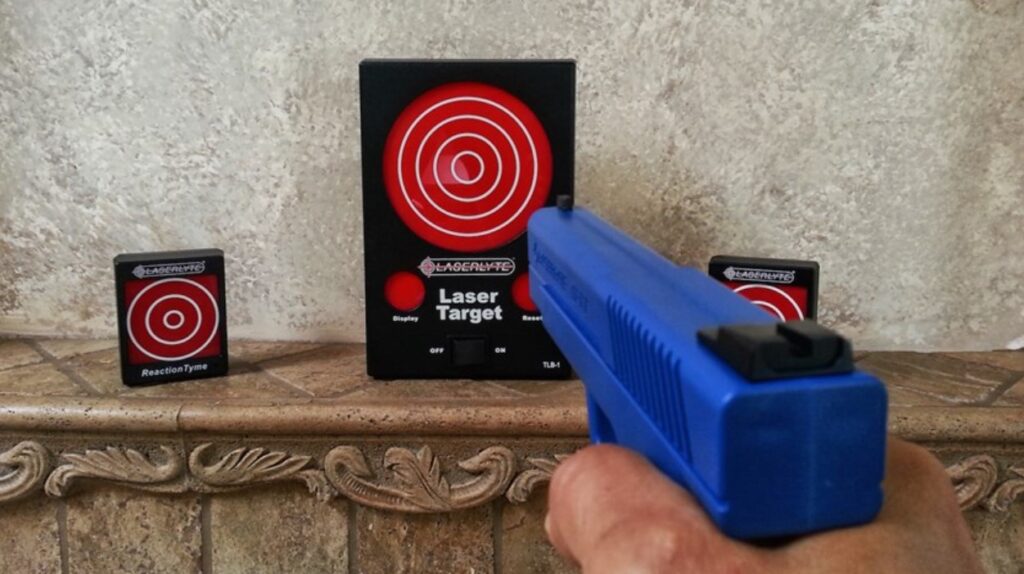Precision shooting is not just about pulling the trigger—it’s about mastering control, accuracy, and muscle memory. Whether you’re a new handgun owner or a seasoned shooter, consistent training is crucial. One of the most effective and innovative methods gaining popularity among firearm enthusiasts is Laser Target Practice. This technique offers a cost-effective, safe, and convenient way to sharpen your shooting skills, often from the comfort of your home.
What is Laser Target Practice?
Laser Target Practice involves using a laser training device—typically a cartridge-shaped insert or a laser-equipped training pistol—that emits a laser “shot” when the trigger is pulled. These shots are visible on special laser targets or can be tracked using mobile apps and reactive targets. Unlike live-fire training, it doesn’t involve live ammunition, making it safe for indoor environments.
Why Choose Laser Target Practice?
There are several compelling reasons why handgun owners are incorporating laser training into their routines:
- Cost-Effective: Ammunition prices continue to climb, and range fees can add up. Laser training saves money in the long run.
- Safe Practice: No live ammunition means there’s zero risk of accidental discharge, allowing for stress-free repetitions.
- Convenience: Practice at home, any time of day, without heading to the range.
- Instant Feedback: Many laser systems offer visual or app-based feedback, helping users analyze and improve their aim.
- Skill Maintenance: Perfect for maintaining muscle memory and trigger discipline between live fire sessions.
Essential Tools for Laser Target Practice
To get started with laser training, you’ll need a few key pieces of equipment:
1. Laser Training Cartridges
These are caliber-specific cartridges (e.g., 9mm, .45 ACP, etc.) that fit into the chamber of your firearm. When the trigger is pulled, a laser beam is emitted briefly to simulate a shot. Brands like LaserLyte, Pink Rhino, and Laser Ammo offer a variety of reliable options.
2. Laser Training Pistols
If you prefer not to use your actual handgun, there are dedicated training pistols such as the SIRT (Shot Indicating Resetting Trigger) pistol. These mimic real handgun weight and feel, and some models allow you to adjust the trigger resistance.
3. Reactive Laser Targets
Laser-compatible targets respond with lights or sounds when hit. Some reset automatically, while others are app-connected for scoring and drills. Examples include LaserLyte’s reaction targets, Mantis Laser Academy, and LaserHit systems.
4. Smartphone Apps and Laser Systems
Apps like MantisX, iTarget, and LaserHit turn your phone into a laser shot analyzer. Using the phone’s camera, they track laser hits and provide instant feedback on accuracy, grouping, and reaction time.
5. Backdrops and Safe Environments
Even though you’re not using live ammunition, always practice laser training in a safe, uncluttered area. A dedicated target backdrop ensures consistent performance and avoids misfires hitting fragile objects.
Tips for Effective Laser Target Practice
1. Focus on Trigger Control
Poor trigger discipline is one of the most common reasons for inaccuracy. Laser systems visually display how the muzzle moves when you pull the trigger, allowing you to fine-tune your pressure for cleaner shots.
2. Use Dry Fire Techniques
Laser practice pairs perfectly with dry fire routines. Practice drawing from a holster, acquiring your sight picture, and smoothly pressing the trigger. This develops muscle memory without wearing out your firearm’s firing pin (modern laser cartridges help cushion it).
3. Incorporate Drills
Set up drills like the “Bill Drill” or “El Presidente” using laser targets. This adds variety and challenges, helping you measure progress and identify weaknesses.
4. Record and Review
Some systems allow video playback or logging of session data. Reviewing your performance over time helps track improvements and refine your technique.
5. Maintain a Consistent Routine
Just 10–15 minutes a day can significantly improve your shooting fundamentals. Create a consistent schedule that aligns with your skill goals—whether it’s speed, precision, or holster draw proficiency.
Laser Target Practice for Competitive Shooters
Many competitive shooters incorporate laser training into their daily routines. Practicing sight alignment, transitions between targets, and trigger timing without burning through live rounds gives them an edge when it matters most. Some use advanced software that replicates match conditions and scores shots in real time for analytical insights.
Common Mistakes to Avoid
- Neglecting Realism: Train with your actual handgun (if safe) or realistic training tools to simulate real handling and balance.
- Skipping Safety Checks: Always triple-check your weapon is unloaded before inserting a laser cartridge.
- Overtraining: Quality over quantity. Aim for deliberate, focused repetitions instead of rushed, high-volume sessions.
- Ignoring Fundamentals: Don’t let technology become a crutch. Practice stance, grip, and breathing alongside laser practice.
Is Laser Target Practice a Replacement for Live Fire?
Laser training isn’t a complete replacement for live fire but rather a powerful supplement. It allows shooters to refine specific aspects—like draw speed, trigger control, and accuracy—between trips to the range. However, live fire is essential for managing recoil, noise, and real-world stressors.
Conclusion
Laser Target Practice offers an unparalleled opportunity to improve handgun skills safely, affordably, and efficiently. Whether you’re new to firearms or a competitive shooter, the combination of instant feedback, structured drills, and advanced tools makes laser training an essential part of your regimen. Embrace technology, train consistently, and your time on the range will be more effective than ever.
So load that laser cartridge, set up your targets, and take aim—because smarter practice leads to better shooting.

